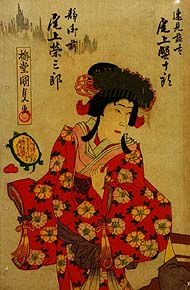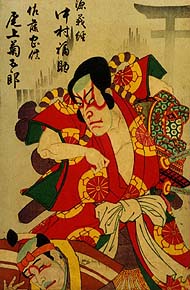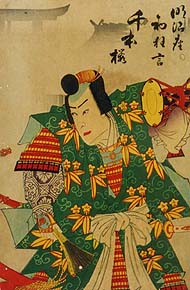| TORII MAE |
| Play title | Yoshitsune Senbon Zakura Yoshitsune and the Thousand Cherry Trees |
| Authors | Takeda Izumo II Miyoshi Sh˘raku Namiki Senryű I |
| History | The play "Yoshitsune Senbon Zakura" was originally written for the puppet theater (Bunraku) and staged for the first time in the 11th lunar month of 1747 in ďsaka at the Takemotoza. It was adapted for Kabuki the following year and staged for the first time in the 1st lunar month of 1748 in Ise with Kataoka Nizaemon IV (Tokaiya Ginpei, Yokawa no Zenji Kakuhan) and Yamamoto Koheiji (Tadanobu). It was performed for the first time in a city licensed theater in the 5th lunar month of 1748, in Edo at the Nakamuraza [casting]. |
| Structure |
The "Torii Mae" scene, which is sometimes performed alone and always included in a t˘shi ky˘gen performance of "Yoshitsune Senbon Zakura", usually as the first act of the program, is in fact the first scene of act II. |
| Key words |
Aragoto Genpei-kassenmono Gidayű Ky˘gen Giri/Ninj˘ Jidaimono Kamei Rokur˘ Kamei Shigekiyo Minamoto Yoritomo Minamoto Yoshitsune Musashib˘ Benkei Torii Yoshitsune Shitenn˘ |
| Summary |
Previous scene: "Heisoto" Fushimi Inari Torii Mae Yoshitsune and his four faithful retainers, Kamei Rokur˘, Kataoka Hachir˘, Ise Sabur˘ and Suruga Jir˘, fleeing Yoritomo's troupes, arrive at the Fushimi Inari Shrine, located in the South of the imperial capital Ky˘to. Yoshitsune, who desperately wants to avoid fighting his brother Yoritomo at any cost, tells his men not to turn against Yoritomo's soldiers. His concubine Shizuka Gozen, makes her appearance on the hanamichi and runs to his lover. She begs for being allowed to travel with the 5 warriors but they tell her they can't take her along in their flight and she has to go back to Ky˘to. Then comes another faithful retainer of Yoshitsune, the monk warrior Musashib˘ Benkei, who is responsible for the hasty flight of Yoshitsune from the Imperial Palace. In a previous scene, which is almost never performed nowadays, Benkei killed one of Yoritomo's men, putting an end to any hope for reconciliation between the two brothers. Yoshitsune rebukes Benkei for the rash killing and the strong monk warrior starts to cry for the first time in his life. He is defended by Shizuka Gozen who says that Benkei acted out of loyalty for Yoshitsune and therefore he should be forgiven. Yoshitsune finally pardons Benkei and allows him to join the escaping band. Shizuka Gozen is not allowed to travel with them but, as a token of love, Yoshitsune gives her the hand-drum called Hatsune, which he received from the retired emperor Goshirakawa in the first scene of the play (hardly performed in Kabuki but still part of the Bunraku repertoire - the faces of the drums represent the 2 brothers (Yoritomo/Yoshitsune) and it could be interpreted 2 different ways: is it a signal from the retired emperor to reconcile with his brother or to kill him?). Yoshitsune has pledged himself to never strike the drum because he is unable to fight against his elder brother. Shikuza accepts the present but still insists strongly to go with him. Yoshitsune asks his men to bind Shizuka to a tree, using the drum's cord. They finally leave the stage through the Shrine Torii gate. A comical character named Hayami no T˘ta appears on the hanamichi, leading a troupe of footmen. He is happy to find Shizuka Gozen and is about to take her away when suddenly a powerful warrior appears from nowhere. He's Sat˘ Tadanobu, another Yoshitsune's faithful retainer. He comes to Shizuka Gozen's rescue and, in a spectacular and comical tachimawari, has no problem to drive Yoritomo's forces away from the stage. T˘ta is killed when he tries to run away with the drum. Yoshitsune, who has witnessed the fighting scene, reappears from the Torii gate of the shrine and thanks his retainer for the successful rescue of Shizuka Gozen. Yoshitsune is a little bit suspicious because Tadanobu is supposed to be off duty, spending his days in his province, far way from Ky˘to, taking care of her ailing mother. Tabanodu answers that he has heard of the troubles between the 2 brothers and has run as quick as possible to join his master. Yoshitsune gives Tadanobu two presents: the name "Genkur˘" and a splendid armour. He also orders him to go to Ky˘to with Shizuka Gozen and stay there with her. The stage curtain is drawn, Shizuka Gozen goes down the hanamichi and Tadabonu is left alone. Shizuka beats the drum and Tadanobu's behavior is no more the one of a human being but of a strange human-looking animal, his hands looking like pawns. He is in fact not the real Sat˘ Tadanobu but a fox disguised as Tadanobu, who has come here because ... well, I prefer not to tell it here and let you read the pages on the "Yoshinoyama" and "Kawatsura H˘gen Yakata" scenes. The fox Tadanobu executes an impressive exit down the hanamichi called "Kitsune Ropp˘" (fox ropp˘). Next scene: "Tokaiya" |
| Trivia |
The comical villain is sometimes Sasame Chűta instead of Hayami no T˘ta. This name is used when Hayami no T˘ta is in the casting of the "Yoshinoyama" scene of "Yoshitsune Senbon Zakura". |
 |
 |
 |
|
The actors Onoe Eizabur˘ V, Onoe Kikugor˘ V, Onoe Kanijűr˘ II and Nakamura Fukusuke IV playing the roles of Shizuka Gozen, Tadanobu, Hayami no T˘ta and Yoshitsune in the "Torii Mae" scene of the drama "Yoshitsune Senbon Zakura", which was staged in January 1896 in T˘ky˘ at the Meijiza (print made by Utagawa Kunisada III) |
||
|
|
| Contact | Main | Top | Updates | Actors | Plays | Playwrights | Programs | Links | FAQ | Glossary | Chronology | Illustrations | Prints | Characters | Derivatives | Theaters | Coming soon | News |